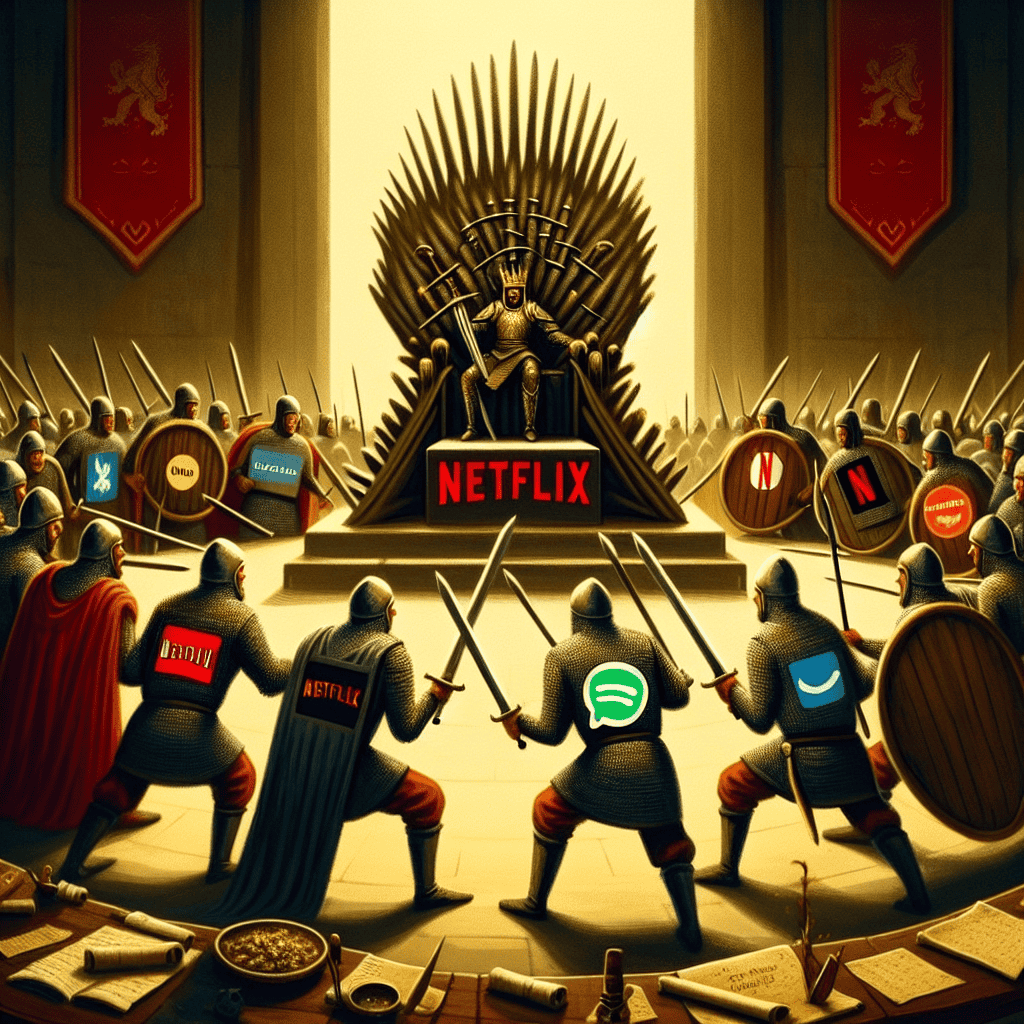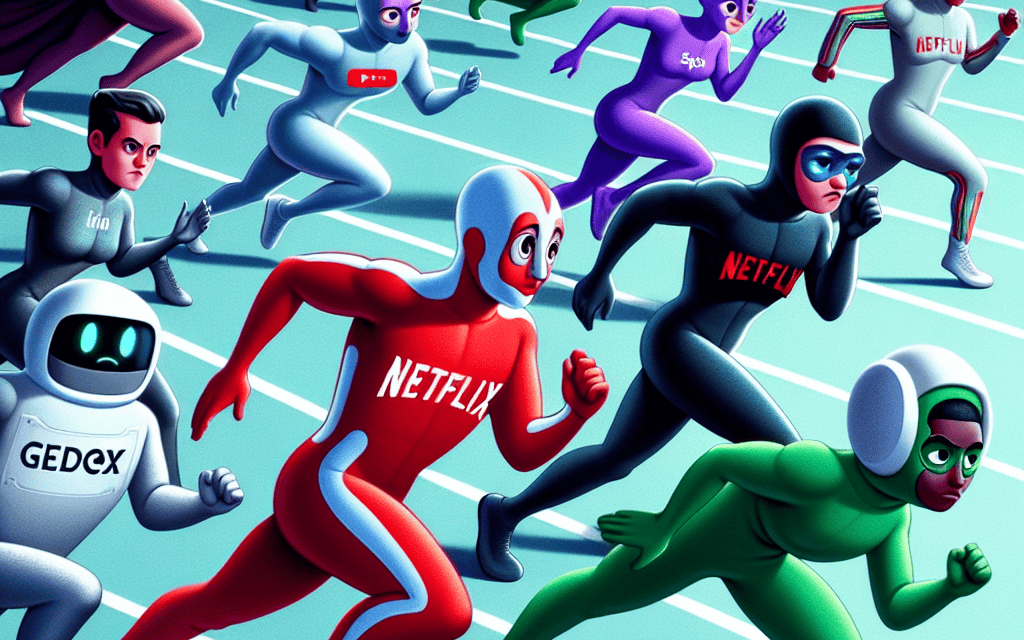“Rivals Rewind: Crafting the Next Wave to Dethrone Netflix’s Reign.”
Introduction
In the rapidly evolving landscape of digital entertainment, Netflix has long held a dominant position as the premier streaming service, captivating audiences worldwide with its vast library of content and innovative approach to on-demand viewing. However, as the streaming market becomes increasingly saturated, competitors are strategizing to challenge Netflix’s supremacy. These challengers are leveraging a combination of exclusive content, strategic partnerships, technological advancements, and competitive pricing models to carve out their own niches in the industry. By investing heavily in original programming, acquiring popular franchises, and expanding their global reach, these companies aim to attract diverse audiences and offer compelling alternatives to Netflix’s offerings. Additionally, the integration of advanced technologies such as artificial intelligence for personalized recommendations and the exploration of interactive and immersive content experiences are key tactics being employed to capture viewer interest and loyalty. As the battle for streaming dominance intensifies, the strategies adopted by Netflix’s competitors will play a crucial role in reshaping the future of digital entertainment.
Diversification Of Content Libraries
In the rapidly evolving landscape of digital entertainment, the streaming industry has become a battleground for companies vying to capture the attention of global audiences. Netflix, a pioneer in this domain, has long held a dominant position, boasting a vast subscriber base and an extensive content library. However, as the market matures, competitors are increasingly seeking innovative strategies to challenge Netflix’s supremacy. One of the most significant approaches being adopted is the diversification of content libraries, a tactic that aims to cater to a broader range of viewer preferences and cultural tastes.
To begin with, the diversification of content libraries involves expanding the variety of genres, languages, and formats available to subscribers. This strategy is crucial as it allows streaming platforms to appeal to niche audiences and international markets, which are often underserved by mainstream offerings. For instance, companies like Amazon Prime Video and Disney+ are investing heavily in regional content production, recognizing the potential of local stories to resonate with viewers. By doing so, they not only enhance their appeal in specific regions but also enrich their global content portfolio, thereby attracting a more diverse subscriber base.
Moreover, the inclusion of diverse content is not limited to geographical considerations. Streaming services are increasingly focusing on representing a wide array of voices and perspectives, addressing the growing demand for inclusivity and representation in media. This shift is evident in the commissioning of projects that highlight underrepresented communities and narratives, which in turn fosters a sense of connection and loyalty among viewers who see their experiences reflected on screen. As a result, platforms that prioritize such diversity are better positioned to capture the attention of socially conscious consumers who value authentic storytelling.
In addition to expanding the scope of content, competitors are also exploring innovative content formats to differentiate themselves from Netflix. The rise of interactive storytelling, for example, offers viewers a more engaging and immersive experience, allowing them to influence the narrative’s direction. This format has gained traction with audiences seeking more active participation in their entertainment choices. Furthermore, the integration of augmented reality (AR) and virtual reality (VR) technologies presents new opportunities for content creators to push the boundaries of traditional storytelling, offering unique experiences that can captivate tech-savvy viewers.
Another critical aspect of content diversification is the strategic acquisition of existing intellectual properties (IPs) and partnerships with established creators. By securing the rights to popular franchises or collaborating with renowned filmmakers and showrunners, streaming platforms can leverage existing fan bases and generate buzz around new releases. This approach not only enhances the perceived value of a platform’s content library but also provides a competitive edge in attracting subscribers who are drawn to familiar and beloved stories.
As the streaming industry continues to evolve, the diversification of content libraries emerges as a pivotal strategy for competitors seeking to challenge Netflix’s dominance. By broadening the range of genres, embracing inclusivity, exploring innovative formats, and leveraging established IPs, streaming services can create a more compelling and varied offering that appeals to a wider audience. In doing so, they not only enhance their market position but also contribute to a richer and more diverse media landscape, ultimately benefiting viewers worldwide. As these efforts unfold, it will be intriguing to observe how the dynamics of the streaming industry shift and how Netflix responds to the growing competition.
Strategic Partnerships And Collaborations
In the rapidly evolving landscape of digital entertainment, Netflix has long held a dominant position as the premier streaming service. However, as the market matures, competitors are increasingly seeking innovative strategies to challenge Netflix’s supremacy. One of the most effective approaches being adopted is the formation of strategic partnerships and collaborations. These alliances are not only reshaping the competitive dynamics of the streaming industry but also offering consumers a broader array of content and services.
To begin with, strategic partnerships allow streaming platforms to leverage each other’s strengths, thereby enhancing their competitive edge. For instance, Disney+ has formed alliances with various telecommunications companies to bundle its service with mobile and broadband plans. This strategy not only expands Disney+’s reach but also provides consumers with added value, making it a formidable competitor to Netflix. Similarly, HBO Max has partnered with other WarnerMedia properties to create a cohesive ecosystem of content that appeals to a wide audience. By integrating their offerings, these platforms can provide a more comprehensive entertainment experience, which is crucial in attracting and retaining subscribers.
Moreover, collaborations with content creators and production studios are pivotal in differentiating streaming services. Amazon Prime Video, for example, has entered into exclusive agreements with renowned filmmakers and production houses to produce original content. These collaborations result in unique programming that cannot be found on Netflix, thereby enticing viewers to explore alternative platforms. Additionally, such partnerships often lead to the creation of high-quality content that garners critical acclaim and awards, further enhancing the platform’s reputation and appeal.
In addition to content creation, strategic collaborations extend to technology and innovation. Streaming services are increasingly partnering with tech companies to improve user experience and deliver cutting-edge features. For instance, Apple TV+ has collaborated with various technology firms to integrate advanced streaming capabilities and interactive features into its platform. These technological enhancements not only improve the quality of streaming but also offer personalized viewing experiences, setting these services apart from Netflix.
Furthermore, international collaborations are playing a significant role in challenging Netflix’s global dominance. As streaming platforms seek to expand their footprint beyond domestic markets, partnerships with local content creators and distributors become essential. For example, platforms like Hulu and Amazon Prime Video are investing in regional content by collaborating with local filmmakers and studios. This strategy not only helps in catering to diverse cultural preferences but also aids in capturing a larger share of the international market. By offering content that resonates with local audiences, these platforms can effectively compete with Netflix’s extensive global library.
In conclusion, as the streaming industry becomes increasingly competitive, strategic partnerships and collaborations are proving to be vital tools for platforms aiming to challenge Netflix’s dominance. By leveraging alliances with telecommunications companies, content creators, technology firms, and international partners, competitors are enhancing their offerings and expanding their reach. These collaborations not only provide consumers with a richer and more diverse entertainment experience but also position these platforms as formidable contenders in the streaming wars. As the industry continues to evolve, it is evident that strategic partnerships will remain a cornerstone of competitive strategy, shaping the future of digital entertainment.
Investment In Original Programming
In the rapidly evolving landscape of digital entertainment, the streaming industry has become a battleground for companies vying to capture the attention of global audiences. At the forefront of this competition is Netflix, a pioneer in the streaming domain, known for its extensive library and original content. However, as the market matures, competitors are increasingly investing in original programming to challenge Netflix’s dominance. This strategic shift is not only reshaping the industry but also redefining how content is created and consumed.
To begin with, the investment in original programming by Netflix’s competitors is driven by the need to differentiate themselves in a crowded market. As streaming services proliferate, offering a unique content library becomes crucial for attracting and retaining subscribers. Companies like Amazon Prime Video, Disney+, and HBO Max have recognized this imperative and are channeling significant resources into developing exclusive content. For instance, Amazon has committed billions to producing original series and films, including high-profile projects like “The Lord of the Rings: The Rings of Power,” which aims to capture the imagination of fantasy enthusiasts worldwide.
Moreover, the emphasis on original programming allows these companies to build brand identity and loyalty. Disney+, leveraging its rich legacy of storytelling, has successfully launched original series set in the Marvel and Star Wars universes, drawing in fans who are eager for new narratives within beloved franchises. This strategy not only strengthens Disney’s brand but also creates a dedicated subscriber base that is less likely to churn. Similarly, HBO Max has capitalized on its reputation for high-quality content by producing critically acclaimed series such as “Succession” and “Euphoria,” which have garnered both viewership and accolades.
In addition to brand differentiation, investing in original programming provides a hedge against the rising costs and complexities of licensing third-party content. As content creators become more protective of their intellectual property, securing licensing deals has become increasingly expensive and competitive. By developing their own content, streaming services can mitigate these challenges and maintain greater control over their offerings. This approach also enables them to tailor content to specific audience preferences, thereby enhancing viewer engagement and satisfaction.
Furthermore, the global nature of the streaming industry necessitates a diverse content portfolio that appeals to a wide range of cultural and linguistic demographics. Competitors are therefore investing in original programming that reflects this diversity, producing content in multiple languages and exploring stories from different cultural perspectives. Netflix itself has demonstrated the success of this strategy with international hits like “Money Heist” and “Squid Game,” prompting others to follow suit. For example, Apple TV+ has expanded its original content slate to include international productions, aiming to capture audiences beyond the English-speaking world.
As competitors continue to invest in original programming, the streaming industry is poised for further transformation. This trend not only intensifies the competition but also enriches the content available to viewers, offering a broader array of choices than ever before. While Netflix remains a formidable player, the concerted efforts of its rivals underscore the dynamic nature of the industry and the relentless pursuit of innovation. Ultimately, the beneficiaries of this competition are the consumers, who can enjoy an ever-expanding universe of stories and experiences at their fingertips.
Expansion Into Emerging Markets

As the global streaming landscape continues to evolve, Netflix’s dominance is increasingly being challenged by competitors seeking to expand their reach into emerging markets. These regions, characterized by rapidly growing internet penetration and a burgeoning middle class, present lucrative opportunities for streaming services aiming to capture new audiences. To effectively compete with Netflix, companies are employing a variety of strategies tailored to the unique demands and preferences of these diverse markets.
One of the primary strategies involves localizing content to resonate with regional audiences. Competitors are investing heavily in the production of original content that reflects the cultural nuances and storytelling traditions of specific areas. For instance, Amazon Prime Video and Disney+ have been actively collaborating with local filmmakers and producers to create content that appeals to local tastes. This approach not only helps in building a loyal subscriber base but also enhances the brand’s cultural relevance in these markets. By offering content that is both relatable and engaging, these companies aim to differentiate themselves from Netflix, which, despite its extensive library, may not always cater to local preferences.
In addition to content localization, pricing strategies play a crucial role in attracting subscribers in emerging markets. Recognizing the varying economic conditions across different regions, competitors are adopting flexible pricing models to make their services more accessible. For example, some companies are introducing mobile-only plans at reduced rates, acknowledging the high mobile phone usage in these areas. This strategy not only lowers the entry barrier for potential subscribers but also aligns with the consumption habits of users who primarily access content via smartphones. By offering affordable and convenient options, streaming services can effectively compete with Netflix, which has traditionally maintained a more uniform pricing structure.
Furthermore, partnerships with local telecommunications companies are proving to be a valuable tactic for expanding into emerging markets. By bundling streaming services with mobile data plans or broadband packages, competitors can leverage the existing customer base of telecom providers to boost their subscriber numbers. Such collaborations also facilitate easier payment solutions, addressing the challenge of limited access to international payment methods in some regions. This symbiotic relationship benefits both parties, as telecom companies can enhance their service offerings while streaming platforms gain a foothold in new markets.
Technological innovation is another area where competitors are seeking to outpace Netflix. By optimizing their platforms for low-bandwidth environments, streaming services can ensure a seamless viewing experience even in regions with less robust internet infrastructure. This involves employing advanced compression technologies and adaptive streaming techniques that minimize data usage without compromising on quality. As a result, users in emerging markets can enjoy uninterrupted access to content, thereby increasing the appeal of these platforms over Netflix, which may not always prioritize such optimizations.
In conclusion, as competitors strive to challenge Netflix’s streaming dominance, their expansion into emerging markets is marked by a multifaceted approach that includes content localization, strategic pricing, partnerships with telecom providers, and technological innovation. By tailoring their strategies to the specific needs and preferences of these regions, streaming services are not only positioning themselves as viable alternatives to Netflix but are also contributing to the dynamic and competitive nature of the global streaming industry. As these efforts continue to unfold, it will be intriguing to observe how Netflix responds to maintain its leadership position in this rapidly changing landscape.
Enhanced User Experience And Technology
In the rapidly evolving landscape of digital entertainment, Netflix has long held a dominant position as the premier streaming service. However, as the market matures, competitors are increasingly focusing on enhancing user experience and leveraging advanced technology to challenge Netflix’s supremacy. This strategic shift is not only about content but also about how that content is delivered and experienced by viewers.
To begin with, one of the primary areas where competitors are making significant strides is in the personalization of content. While Netflix has been a pioneer in using algorithms to recommend shows and movies, other streaming services are now investing heavily in artificial intelligence and machine learning to refine their recommendation engines. By analyzing user behavior more intricately, these platforms aim to offer a more tailored viewing experience, thereby increasing user engagement and satisfaction. For instance, Disney+ and Amazon Prime Video are continuously updating their algorithms to ensure that their vast libraries are not just accessible but also relevant to individual users’ preferences.
Moreover, the integration of cutting-edge technology is another avenue through which competitors are seeking to enhance user experience. High-definition streaming, including 4K and HDR content, is becoming a standard offering, with services like Apple TV+ and HBO Max pushing the envelope further by experimenting with immersive technologies such as virtual reality (VR) and augmented reality (AR). These innovations promise to transform passive viewing into an interactive experience, potentially attracting tech-savvy audiences who crave more than traditional screen time.
In addition to technological advancements, user interface design is receiving considerable attention. Competitors are investing in intuitive and aesthetically pleasing interfaces that facilitate seamless navigation and discovery. The goal is to minimize friction points that could lead to user frustration. For example, Peacock and Hulu have been rolling out updates that streamline content discovery, making it easier for users to find new shows and movies without feeling overwhelmed by choice. This focus on user-centric design is crucial in retaining subscribers who might otherwise be tempted to switch platforms.
Furthermore, the importance of cross-platform compatibility cannot be overstated. As consumers increasingly use a variety of devices to access content, from smartphones to smart TVs, streaming services are prioritizing the development of apps that offer a consistent experience across all platforms. This includes optimizing for different screen sizes and ensuring that features such as offline viewing and multi-device synchronization work flawlessly. By doing so, services like Paramount+ and Discovery+ are positioning themselves as versatile options for users who demand flexibility in how and where they consume content.
Finally, customer support and community engagement are becoming integral components of the user experience strategy. Competitors are recognizing that providing robust support and fostering a sense of community can significantly enhance user loyalty. Interactive features such as watch parties and live chats are being introduced to create a more social viewing experience, while responsive customer service teams are being established to address technical issues promptly.
In conclusion, as the streaming industry becomes increasingly competitive, enhancing user experience through advanced technology and thoughtful design is emerging as a key strategy for challenging Netflix’s dominance. By focusing on personalization, technological innovation, intuitive interfaces, cross-platform compatibility, and community engagement, competitors are not only meeting the current demands of viewers but also setting the stage for the future of digital entertainment. As these efforts continue to evolve, the streaming landscape is poised for a dynamic shift, offering consumers more choices and better experiences than ever before.
Competitive Pricing Strategies
In the ever-evolving landscape of digital entertainment, Netflix has long held a dominant position as the premier streaming service. However, as the market becomes increasingly saturated, competitors are devising innovative strategies to challenge Netflix’s supremacy. One of the most significant tactics employed by these rivals is the implementation of competitive pricing strategies. By offering more affordable subscription plans, bundling services, and introducing tiered pricing models, these companies aim to attract a broader audience and erode Netflix’s market share.
To begin with, many streaming services are opting to offer lower-priced subscription plans to entice cost-conscious consumers. For instance, platforms like Disney+ and Apple TV+ have entered the market with subscription fees significantly lower than Netflix’s standard plan. This approach not only appeals to budget-minded viewers but also encourages potential subscribers to explore multiple services simultaneously. By positioning themselves as cost-effective alternatives, these competitors hope to capture a segment of the audience that may be hesitant to commit to Netflix’s higher-priced offerings.
In addition to lowering subscription fees, some companies are leveraging bundling strategies to enhance their value proposition. For example, Disney has introduced a bundle that includes Disney+, Hulu, and ESPN+ at a discounted rate. This package not only provides a diverse range of content but also offers significant savings compared to subscribing to each service individually. Such bundling strategies are designed to create a comprehensive entertainment ecosystem that rivals Netflix’s extensive library. By offering a variety of content under one subscription, these companies aim to increase customer retention and attract new subscribers who seek diverse viewing options.
Moreover, the introduction of tiered pricing models has become a popular strategy among streaming services looking to challenge Netflix. By offering multiple subscription tiers with varying levels of access and features, companies can cater to a wider range of consumer preferences. For instance, some platforms provide basic plans with limited content and advertisements at a lower price point, while premium plans offer ad-free viewing and exclusive content. This flexibility allows consumers to choose a plan that best suits their needs and budget, potentially drawing them away from Netflix’s more uniform pricing structure.
Furthermore, some competitors are experimenting with innovative pricing models that deviate from the traditional subscription format. For example, Amazon Prime Video offers a pay-per-view option for certain content, allowing viewers to rent or purchase individual movies and shows. This model provides an alternative for consumers who prefer not to commit to a monthly subscription, thereby expanding the potential customer base. By offering diverse pricing options, these companies aim to capture a wider audience and challenge Netflix’s dominance in the streaming market.
In conclusion, as the streaming industry becomes increasingly competitive, companies are employing a variety of pricing strategies to challenge Netflix’s market leadership. By offering lower-priced subscription plans, bundling services, and introducing tiered pricing models, these competitors are positioning themselves as attractive alternatives for consumers. Additionally, innovative pricing models such as pay-per-view options further diversify the market and provide consumers with more choices. As these strategies continue to evolve, it remains to be seen how Netflix will respond to maintain its position in the ever-changing landscape of digital entertainment. Nevertheless, the ongoing battle for streaming supremacy promises to deliver exciting developments for consumers and industry observers alike.
Focus On Niche Audiences And Genres
In the ever-evolving landscape of digital entertainment, Netflix has long held a dominant position as the premier streaming service. However, as the market matures, competitors are increasingly seeking innovative strategies to carve out their own niches and challenge Netflix’s supremacy. One of the most promising approaches involves focusing on niche audiences and genres, a tactic that allows these companies to differentiate themselves and cater to specific viewer preferences.
To begin with, the streaming industry has witnessed a proliferation of platforms that target particular demographics or interests. For instance, services like Crunchyroll and Funimation have capitalized on the growing popularity of anime, offering extensive libraries that appeal to dedicated fans of the genre. By concentrating on a specific type of content, these platforms can provide a more tailored experience than Netflix, which, despite its vast catalog, may not always meet the nuanced demands of niche audiences. This specialization not only attracts loyal subscribers but also fosters a sense of community among viewers who share similar tastes.
Moreover, the rise of niche streaming services is not limited to anime. Platforms such as Shudder, which focuses on horror films and series, and BritBox, which offers British television content, exemplify how targeting specific genres can be a successful strategy. These services curate their offerings to cater to enthusiasts who are passionate about particular types of content, thereby creating a unique value proposition that distinguishes them from more generalized platforms like Netflix. By honing in on specific genres, these companies can also invest in original content that aligns with their audience’s interests, further solidifying their position in the market.
In addition to genre-specific platforms, some competitors are leveraging cultural and regional content to attract niche audiences. For example, services like Viki and Eros Now focus on Asian dramas and Indian cinema, respectively, tapping into the vast potential of international markets. By providing content that resonates with cultural identities and preferences, these platforms can build strong connections with viewers who may feel underserved by mainstream offerings. This approach not only broadens the appeal of streaming services but also highlights the importance of diversity and representation in the entertainment industry.
Furthermore, the emphasis on niche audiences and genres allows streaming services to experiment with innovative business models and marketing strategies. For instance, some platforms offer tiered subscription plans or ad-supported options to accommodate different consumer preferences and budgets. Others engage with their audiences through social media and fan events, fostering a sense of community and loyalty that extends beyond the screen. These tactics enable companies to build a dedicated subscriber base that is less likely to churn, even in the face of competition from larger players like Netflix.
In conclusion, as the streaming industry continues to expand, focusing on niche audiences and genres presents a viable path for competitors seeking to challenge Netflix’s dominance. By catering to specific viewer preferences and offering curated content that resonates with particular interests, these platforms can differentiate themselves in a crowded market. Moreover, the ability to connect with audiences on a deeper level through cultural and genre-specific content underscores the potential for growth and innovation in the streaming sector. As more companies adopt this strategy, the landscape of digital entertainment is poised to become increasingly diverse and dynamic, offering viewers a wealth of options tailored to their unique tastes.
Q&A
1. **Content Diversification**: Competitors are investing heavily in original content and acquiring exclusive rights to popular franchises to attract diverse audiences and differentiate themselves from Netflix.
2. **Pricing Strategies**: Many streaming services are offering competitive pricing models, including ad-supported tiers and bundle deals, to provide more affordable options compared to Netflix’s subscription plans.
3. **Global Expansion**: Companies are focusing on expanding their reach in international markets by tailoring content to local tastes and languages, aiming to capture audiences that Netflix has yet to dominate.
4. **Technology and User Experience**: Enhancements in streaming technology, such as improved recommendation algorithms and user-friendly interfaces, are being prioritized to offer a seamless viewing experience.
5. **Partnerships and Collaborations**: Forming strategic partnerships with telecom companies, device manufacturers, and other media entities to increase distribution and accessibility of their streaming platforms.
6. **Niche Content Focus**: Some competitors are targeting specific niches or genres, such as horror, anime, or documentaries, to build a loyal audience base that seeks specialized content.
7. **Live and Interactive Content**: Incorporating live events, sports, and interactive content to engage viewers in real-time experiences that Netflix traditionally does not offer.
Conclusion
Competitors are strategically challenging Netflix’s streaming dominance through a variety of approaches. Firstly, they are investing heavily in original content to differentiate their offerings and attract diverse audiences. Companies like Disney+, Amazon Prime Video, and HBO Max are leveraging their vast libraries of popular franchises and exclusive content to draw subscribers. Secondly, they are exploring innovative pricing models, such as ad-supported tiers, to offer more affordable options and expand their user base. Additionally, partnerships and bundling strategies are being employed to enhance value propositions, as seen with Disney’s bundle of Disney+, Hulu, and ESPN+. Competitors are also focusing on international expansion, tailoring content to local markets to capture global audiences. Furthermore, advancements in technology, such as improved user interfaces and personalized recommendations, are being prioritized to enhance user experience. By adopting these multifaceted strategies, competitors aim to erode Netflix’s market share and establish themselves as formidable players in the streaming industry.





